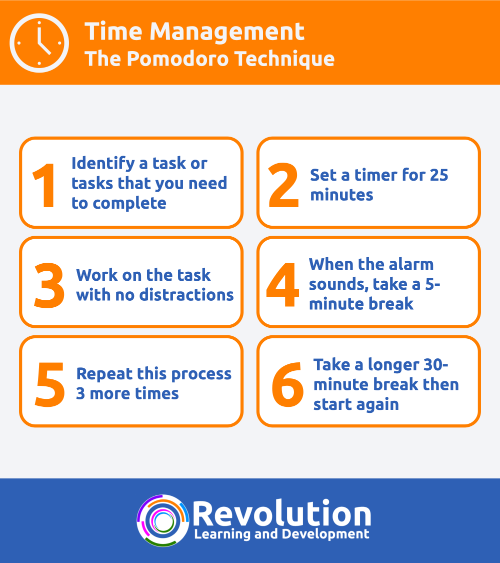Background
The Pomodoro Technique is a time management tool that helps us to work more productively. Developed in the 1980s by Francesco Cirillo, the technique has become widely used by people to increase the amount of work that they get done in shorter amounts of time.
The principle of the Pomodoro Technique is a simple one – it suggests that we break our time up into smaller chunks, work in smaller bursts and take more regular breaks. To ensure those breaks are taken, a timer should be used to tell us to stop.
Cirillo used a kitchen timer shaped like a tomato, hence the name of the technique coming from Pomodoro – the Italian word for tomato.
The Pomodoro Technique

There are 6 major steps to the Pomodoro Technique:
- Identify a task or tasks that you need to complete
- Set a timer for 25 minutes
- Work on a task with no distractions
- When the alarm sounds, take a 5-minute break
- Repeat the process 3 more times
- Take a longer 30-minute break and start again
Pomodoro Technique – Step 1 – Identify Tasks
Step 1 of the pomodoro technique is to identify a task or a range of tasks that you need to complete. Ideally, your tasks should be short tasks. If you have a bigger task to complete, break this down into smaller tasks that should take no more than 25 minutes to complete.
Put your tasks in order of completion and be very clear in your mind of what you want the outcome to look like.
Pomodoro Technique – Step 2 – Set a Timer
Step 2 of the pomodoro technique is to set a timer for 25 minutes. Do not try and do this in your head. You need something to alert you that 25 minutes is up. It may be that the noise needs to snap you out of a concentrated state.
Use the clock function on your phone or a stop-clock or some other kind of timer.
Pomodoro Technique – Step 3 – Work on the Tasks
Step 3 of the pomodoro technique is to work on your tasks. Only focus on this task so avoid any interruptions or distractions. You need to be able to concentrate for this very short period of time.
Pomodoro Technique – Step 4 – Take a Short Break
Step 4 of the pomodoro technique is to take a 5-minute break when the alarm sounds. Do not be tempted to go any longer, discipline yourself to stop when the alarm sounds, move away from what you are doing and take a break.
The idea here is to physically move away from your workspace. So get up, move around or better still go to a different location.
Pomodoro Technique – Step 5 – Repeat
Step 5 of the pomodoro technique is to repeat steps 2 and 3 three more times, so you have completed 4 repetitions in total.
Pomodoro Technique – Step 6 – Take a Long Break
Step 6 of the pomodoro technique is to take a longer 30-minute break after your 4 repetitions. If all of your tasks are complete, then take a break anyway before you move on to something else. If your tasks are not complete, take a 30-minute break and then repeat steps 2 to 4 until you have everything done that you need to get done.
Why Use the Pomodoro Technique?
Taking shorter breaks allows for increased levels of productivity and focus. The thought many people have is that longer periods of concentration will help us to get more done. The reality is, the more we are in those concentrated states, the more we lose track of time and this can mean that tasks actually take longer than we intend them to.
Breaking out of that state and taking a break allows more intense focus and also means that we are constantly consciously aware of the time we have and how long things are taking.
You should find that you have higher levels of energy and therefore higher levels of concentration, focus and productivity.
Further Learning
You can learn more about the Pomodoro Technique by attending a time management training course. Take a look at our time management training course for more details.




